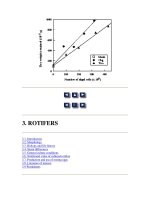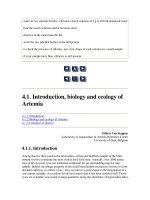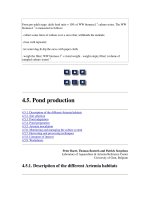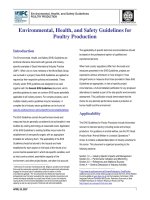Rubber Budwood Production ppt
Bạn đang xem bản rút gọn của tài liệu. Xem và tải ngay bản đầy đủ của tài liệu tại đây (443.61 KB, 21 trang )
Dr. Moises Glenn G. Tangalin graduated with a degree
of Bachelor of Science in Agriculture at Zamboanga del
Sur Agricultural College now JH. Cerilles State College. He
finished his Master of Agricultural Development at
Visayas State College of Agriculture (VisCA) in 1999 with
a major field of specialization in animal production. He
finished is Doctor of Education major in Educational
Management at Medina College, Ozamiz City in 2003.
He worked as an Associate Professor in the
College of Agriculture. Member in the Regional Management Information Services in
WESMARRDEC and a focal person in Dumingag Farmers Information Technology Service
Center and the Team Leader as Partner Member Agency (PMA) in 3 FITS Centers in
Zamboanga del Sur namely; Pagadian City FITS Center, Ramon Magsaysay FITS Center
and Dumingag FITS Center. Attended and conducted trainings in asexual propagation
and nursery management in the municipality as part of the extension activities of the
school.
Currently, he is the Director for the Research and Extension Services of the JHCSC
Dumingag Campus for more than 6 years.
Prof. Pepito L. Lacbao graduated with a degree of
Bachelor of Science in Agriculture with major in Plant
Pathology at the University of Southern Mindanao (USM)
in 1978 and M.S. in Agronomy at the same University as
scholar USM-UPLB-NFAC country side Action Program in
1988. He also finished the academic requirements leading
to the degree of Doctor of Education at WMSU and
finishing his Doctor of Rural Development at the Ilo-Ilo
State College of Fisheries (SCOF).
He worked as Field Technician of the USM-SEARCA
Social Laboratory Project for two (2) years and as Graduated Research Assistant of the
USM-UPLB-NFAC Countryside Action Program for three (3) years before his transfer to
the Western Mindanao State University in 1982 where he was assigned to handle Agri-
Projects as Project Manager and at the same Chairman of the Research and Extension
Department. He was the Dean of the College of Agriculture from 1988-2003.
Currently, he is the Chairman of the Crop Science Department teaching Crop
Science subject for 27 years.
i
ACKNOWLEDGEMENT
This training module was made possible through the support of various
individuals and institutions to whom we acknowledge and express our thanks:
The Department of Science and Technology (DOST) through the Philippine
Council for Agriculture, Forestry and Natural Resources Research and Development
(PCARRD) for the funding support that enables the Western Mindanao State University
(WMSU), College of Agriculture and other partner institutions in Western Mindanao to
participate in the National Program on Enhancing the Demand for AFNR graduates
through science and technology interventions;
The Western Mindanao State University through its University President, Dr.
Grace J. Rebollos and the Heads of other involved Institutions for their commitment,
leadership and guidance in the implementation of the program particularly in the
preparation of this training module;
Dr. Teresita A. Narvaez, Dr. Chona Q. Sarmiento, Dr. Frede Moreno, Dr. Moises
Glenn Tangalin, Dr. Vivian Molina, Dr. Paterna Saavedra, Engr. Danilo L. Fonollera and
Prof. Oliver O. Tito, Project Coordinators for their guidance and sharing of their
knowledge and skills in the preparation of this module; and
Our colleagues in the AFNR Project for their support, valuable input and
camaraderie that resulted in the final write up of this module.
ii
MODULE DESCRIPTION
This module was designed to enhance and enrich the knowledge and skills of the
participants on the production of rubber seedlings and management practices. It also
provides the participants an opportunity to establish nursery enterprise as self
sustaining livelihood project.
iii
List of Figures
FIGURE PAGE
Figure 1. RRIM 600 4
Figure 2. PB 235 4
Figure 3. PB 217 5
Figure 4. PB 260 5
Figure 5. PB 330 6
Figure 6. Field layout and distance of planting for budwood garden 6
Figure 7. Ready for Harvest Budwood garden 10
iv
Table of Contents
Page
ACKNOWLEDGEMENT i
MODULE DESCRIPTION ii
List of Figures iii
INTRODUCTION 1
Time frame 2
Goals 2
Learning Outcomes 2
1. Budwood Garden Establishment 3
Site Selection 3
Land Preparation 3
Selection of Quality Clones 3
Planting and Planting Distance 6
2. Budwood Garden Maintenance and Management Practices 7
Fertilization 7
Weed Control 7
Plant Disease and Control 8
Insect Pest and Control 8
Vertebrates and Mollusk 9
3. Harvesting and Packing of Budwwod and Budsticks 10
Harvesting 10
Packing of Budwoods and Budsticks 11
Summary 12
Evaluation 13
REFERENCES 14
Module 8: Rubber Nursery Management 1
INTRODUCTION
The content of the module is divided into four major topics.
1. Establishment of budwood garden
2. Selection of quality clones
3. Growing management
4. Harvesting and Packing of budsticks
Topic I deals with the establishment practices and techniques and maintenance
of rubber budwood garden as a source of quality clones and budeye for asexual
propagation (budding) in rubber seedlings. A detailed discussion of each of the various
activities in the establishment and selection of quality clones, growing management and
harvesting and packing of budsticks are considered in Topics 2, 3, and 4, respectively.
Module 8: Rubber Nursery Management 2
Time Frame
This training module as part of the AFNR enhancement program will be
conducted/implemented within a span of ten (10) months starting first semester of
school year 2009-2010 (June, 2009
March, 2010).
Goals
The goals include:
The development of information materials on rubber budwood
management and quality clone selection for seedling propagation for
dissemination and implementation
superior quality clones budstick materials and budwood garden
management practices and maintenance.
The development of the entrepreneurial action projects on budwood
garden management for AFNR participants to engage and implement.
Learning Outcome
At the end of the training module, each of the participants should be able to:
Identify the ideal site for rubber budwood garden
Understand the importance and advantages of choosing superior and
high yielding rubber clones and the source of fresh and healthy budsticks
to be used for asexual propagation (budding) of seedlings
Describe and discuss the various rubber budwood management practices
and techniques
Learn the proper techniques in harvesting and packing of budsticks for
disposal
Prepare an entrepreneurial action project on rubber budwood garden
Module 9: Rubber Budwood Production 3
1. Budwood Garden Establishment
Generally, the purpose of establishing budwood garden is for the multiplication
of budwood for production of quality rubber planting materials.
Materials
Budded seedlings
Ideal site
Plow and Harrow
Fence
Water Supply
Activities
Site Selection
Select a site based on the following consideration:
The area should be near to source of water and seedling nursery.
Preferably flat to gently undulating terrain with a loose friable and fertile
soil.
Shallow soil with a hard sandstone band near the surface and sandy-
structured soils should be avoided.
Well drained with a water table of at least ½ meter.
Land Preparation
Plow the area once and harrow two (2) to three (3) times at weekly
interval when there is enough moisture.
Remove all debris, weeds, and other unwanted plants.
Fence the perimeter properly to ensure safety of the plants against astray
animals.
Selection of Quality Clones
Clone selection should be given importance in order to have successful
rubber plantation. Optimum yield cannot be attained even with favorable
environment if the clone used is not of a high yielding variety.
Module 9: Rubber Budwood Production 4
Figure 2. PB 235
Figure 1.
RRIM 600
Use the following clones as recommended by the National Seed Industry
Council (NSIC):
1. Rb-99-01 (RRIM 600)
Leaves are green, convex,
obviate, slightly glossy, and
well-separated (Figure 1).
D.R. YIELD (kg/ha/yr): 2,102.54
IMMATURE STAGE
Slow growing with less vigor and erect, smooth stem. Conical storey, is
open with well arranged petioles. Leaf stories are far separated but some
are continuous particularly on short stalks. Late branching occurs at this
stage and these are alternately placed but they appear clustered.
2. Rb-99-02 (PB235)
Dark green, elliptical boat
shaped leaves with sharp tips.
Leaflets are touching each
other older leaves located at
the lower portion of the plant
are convex (Figure 2).
D.R. YIELD (kg/ha/yr): no available data
IMMATURE STAGE
Vigorous clone with broad well-separated stories. Petioles are thick and
light colored. The stems are slightly crooked and knobby with prominent
leaf scars. Flat branches curve upward. Few light lateral grows along the
leader.
Module 9: Rubber Budwood Production 5
Figure 4. PB 260
Figure 3. PB 217
3. Rb-99-04 (PB217)
Light green, obovate v-
shaped leaflets are touching
each other. Close stories and
sometimes petioles are short
and clustered (Figure 3).
D.R. YIELD (kg/ha/yr): 2,161.17
IMMATURE STAGE
Erect
scars. Branches are flat (PB5/5 type) with regular clusters. Leader is
maintained.
4. PB 260
SOURCE BUSH NURSERY
Dark green, broad, oval, and
boat-shaped leaves. Leaflets
are touching each other. Leaf
margins are wavy (Figure 4).
D.R. YIELD (kg/ha/yr): 2,370.0
IMMATURE STAGE
Close conical stories.
Petioles are thick and well clustered smooth straight stem.
Module 9: Rubber Budwood Production 6
5. PB 330
SOURCE BUSH NURSERY
Leaves are dark-green, elliptical,
and are touching each other
(Figure 5).
D.R. YIELD (kg/ha/yr): No available
data
IMMATURE STAGE
Vigorous clone with broad dense leaf storey and clustered flash branches.
Planting and Planting Distance
Prepare beds/blocks with four (4) rows spaced 1 meter at 120 cm
between blocks.
Plant the selected budded seedlings of the same clone together in one
area at a planting distance of 1 m X 1 m (Figure 6)
Place tags showing the correct nomenclature of the clone for proper
identification.
Plant the budded seedlings at the onset of rainy season.
Figure 5. PB 330
1 m
1 m
1m
Figure 6. Field layout and distance of planting for budwood garden
Module 9: Rubber Budwood Production 7
2. Budwood Garden Maintenance and Management Practices
Budded seedlings planted in the budwood garden requires proper management
practices to maintain for at least 10 or more years.
Materials
Fertilizer
Waste and watering equipments
Weeding tools
Sprayer and chemicals
Activities
Fertilization
o Fertilize the seedlings at the rate of 30 grams per plant of complete
fertilizer (14-14-14) applied basally during planting time.
o Apply 25 grams per seedlings of Ammonium Sulfate (16-20-0) at three (3)
to twelve 12 months after transplanting.
o Apply 125 grams per plant of complete fertilizer (14-14-14) during the
second year, for every six months or two (2) to three (3) months after
cutting back the budwood.
o Drill the fertilizer on the soil layer within 7.5 cm depth at 15 to 40 cm
from the based depending on the aged and size of the tree.
Weed Control
The aim of the weed control in the budwood garden is to minimize
competition from weeds for light, water, and nutrients. Mulching with the use of
rice straw, rice hull and saw dust is also effective in controlling weeds.
o Clean-weed the budwood garden regularly at 2 weeks interval by hand
weeding. Frequency of hand weeding is reduced as the plants grow older.
Module 9: Rubber Budwood Production 8
o Spray herbicides using glyphosate (round-up) to control cogon and other
grasses. Use glufosinate (Basta) for mized weeds.
Plant diseases and control
o Spray Dithane M45 at 6 tbsp/4 gal knapsack sprayer on the leaves of the
plant at weekly interval if the plants in the budwood garden are infected
Helminthosporium hevea).
The diseased seedlings can be identified through symptoms. The diseased
plants have spots on the leaf surface with transparent center and brown
borders. Infected young leaves blacken and wrinkle while spot holes form
in the older leaves.
o Spray Vitigran blue, Daconil or Cupravit on the expanded leaves at rate of
10 to 11 tbsp/ 4 gal knapsack sprayer to control Collectotrichum
gloeocosporoides.
This disease can be recognized by numerous protrusions on the surface
of the leaves with pinhead size depressions below. A halo surrounding
the infected portion is observed as the disease continues. The disease
leaves wrinkle and fall later.
o Spray the same rate of fungicides to infected plants with Anthracnose.
The disease can be indentified through a ground or straw-colored lesion
that start from the edge of leaves and moves towards the center.
Insect Pest and Control
o Termites
Inspect termit regularly and destroy
them.
Practice good sanitation in the budwood garden.
Module 9: Rubber Budwood Production 9
o Root-feeding grubs
The grubs live entirely in the soil. They are voracious feeders and
consume the roots of rubber. Following are the activities to control grubs
infestations:
Use polybags in raising rubber seedling.
Do not apply insecticides since the grubs have many natural enemies.
o Sucking insects such as scales, mealy bugs, and aphids
These insects excrete honeydew which attracts ants and sooty molds. In
having infestation, the shoots may die.
Grow rubber seedlings in polybags.
Practice good sanitation.
Chemical control is not needed since sucking insects have many
natural enemies.
Vertebrates Pest and Mollusk
o Rodents
Rats consumed variety of damage to seeds, seedlings, young buddings,
and immature trees.
Sustain baiting by putting five bait stations per hectare.
Practice good sanitation in the budwood garden.
o Slugs and Snail
They feed on terminal buds and side shoots. They often creep to the
tapping panels of mature trees to drink the latex.
Collect and destroy slugs.
Practice good sanitation in the budwood garden.
Module 9: Rubber Budwood Production 10
3. Harvesting and Packing of Budwwod and Budsticks
The first crop of budwoods and budsticks from the branches is produced 10-12
months after planting. Start harvesting the budsticks when it is healthy and properly
fertilized (Figure 7).
Materials
Pruning saw
Knife/bolo
Banana leaf sheaths
Paper or wood boxes
Saw dust
Ladder
Activities
Harvesting
Cut the stems with the used of pruning saw at a height of 25-30 cm from
the union for budwoods and budsticks harvesting.
Temporary place the harvested budsticks in plastic bags under a shaded,
cool place for use in the nearby fields on the same day.
Bring the harvested budststicks in the nursery bed for budding.
Figure 7. Ready for Harvest Budwood garden
Module 9: Rubber Budwood Production 11
Packing of Budwoods and Budsticks
o Budwood
Deep the two cut ends with melted wax to prevent drying.
Pack the budwoods in boxes, lined with layers of moist saw dust to
prevent bruising during transit.
In the absence of the boxes protect a bundle of 25 to 50 budwoods of
atleast one (1) meter long using moisten dried banana leaf sheaths
wrapped alternately per budwood. Use banana bracts to complete
the packing for transport.
If budwoods are not used immediately, these can be preserved for a
week. Cut the base ends of the budsticks that are covered with
paraffin wax.
Soak the cut ends in water about 2.5 to 5 cm deep and keep in a
shaded cool place.
Change the water daily. Likewise, cut both ends of the budwood daily
to facilitate water absorption.
o Budstick
Cut the green budsticks early in the morning. Temporarily keep the
budsticks in plastic bags under the shaded cool place for used in
nearby fields on the same day.
For long distance travel, apply wax on both ends of the green
budsticks then pack in 45 cm X 45 cm X 45 cm boxes for 400 sticks
and 45 cm X 45 cm X 22 cm for 200 sticks. Line the box with dump
aged saw dust (with 40 percent moisture). Separate the layer of green
budsticks with a saw dust. Green budsticks can be stored into 6 days.
Module 9: Rubber Budwood Production 12
SUMMARY
The ultimate aim of a rubber budwood garden establishment is production of
quality scions from recommend clones. To attain this goal, proper management
practices must be employed. This includes site selection, proper land preparation,
planting distance, clone selection, field maintenance, harvesting of budwoods and
budsticks, and packing techniques.
Module 9: Rubber Budwood Production 13
Evaluation
1. Define the following terms
Budwood
Budstick
Clone
Budeye
Budwood Garden
Bud patch
2. What are the rubber clones recommended in our country?
3. Make a sample of design and layout in planting rubber clone.
4. What are the criteria for judging ideal rubber clone?
5. What are the steps in packing budstick/bodwood after harvesting?
6. How do you determine successful and unsuccessful result of green budding?
7. State the recommended age and size in harvesting budstick or budwood.
8. Give the importance of establishing a budwood garden?
9. Actual Identification of superior and quality rubber clones (high yielding).
10. Actual Identification of active budsticks and budwood.
Module 9: Rubber Budwood Production 14
REFERENCES
Alcala, E. A. 2000, Rubber Manual for small holders. USM Philrubber Center, USM,
Kabacan, Cotabato. 74p.
CARRDEC Farm Primer No. 02/2007. ISSN 1908-885X. Farm Primer. Rubber Plantation
Establishment.
Central Mindanao Agriculture and Resources Research and Development
Rubber
Production and Management. University of Southern Mindanao, Kabacan,
Cotabato, 1990. 96p. (Book Series No. 1 1990)
Cerna, R. L. 2006. Professor V and Plant Breeder. USM, Kabacan, Cotabao
Recommended Rubber Clones in the Philippines and Establishment of Rubber
Budwood Garden. Internet.
Comprehensive Rubber Technology Rubber Program. 1990 Rubber Nursery Propagation
and Management. Vol. 1 No. 4. University of Southern Mindanao, Kabacan,
Cotabato. 12p.
Cotabato Agriculture and Resources Research and Development Consortium (CARRDEC)
Techno Series, 2006. Rubber Nursery Management. University of Southern
Mindanao Kabacan, Cotabato. 11p.
Cotabato Agriculture and Resources Research and Development Consortium (CARRDEC)
Rubber Plantation Establishment. Los Baños, Laguna. PCARRD-DOST, CARRDEC-
USM, 2007. 12p. (CARRDEC Farm primer No. 02/2007)
Rubber Nursery Establishment. DA-WESMIARC-FITS-97-03. 7-13p.









